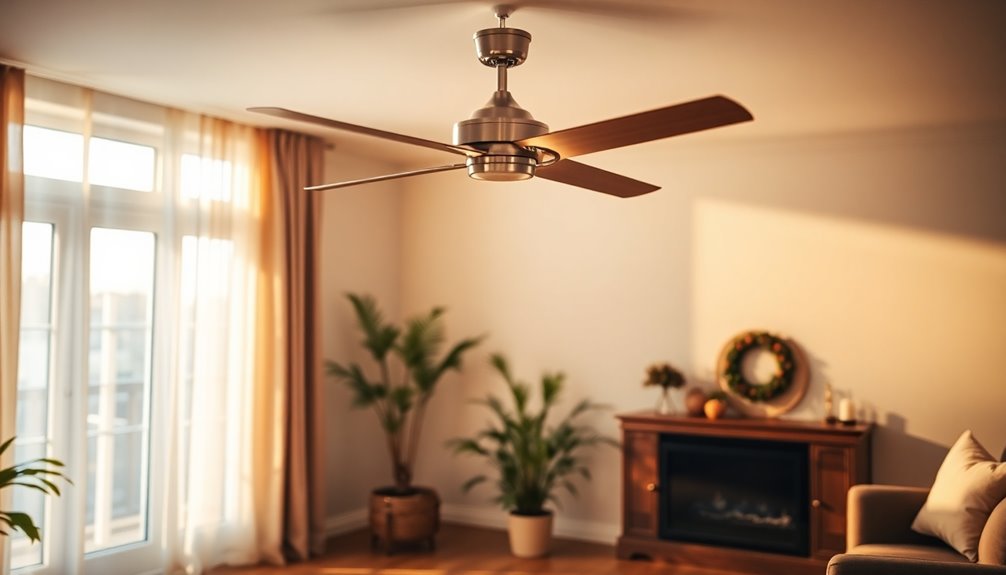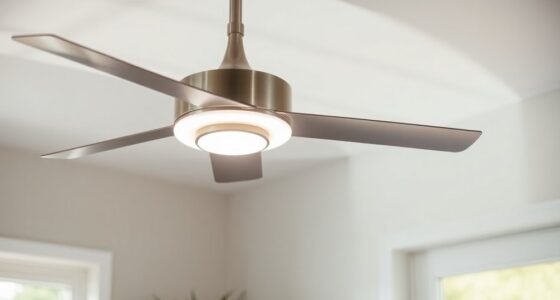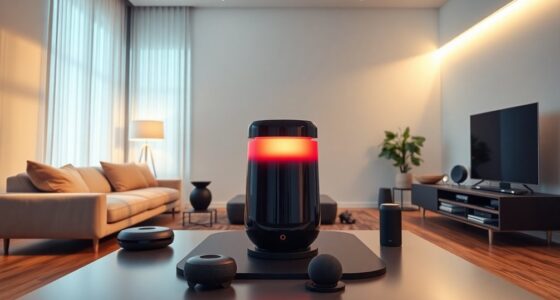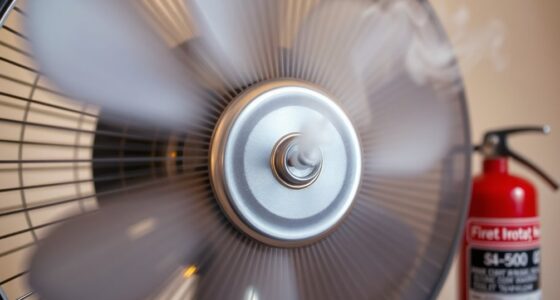The reverse option on a fan changes its direction to adapt to seasonal needs. In summer, setting your fan to spin counterclockwise creates a cool breeze, making the room feel up to 4 degrees cooler. In winter, reversing it to clockwise helps circulate warm air that rises to the ceiling, redistributing heat and eliminating cold spots. This not only boosts comfort but also cuts energy costs considerably—up to 30% in summer and 15% in winter. Understanding how and when to adjust your fan can maximize these benefits, and there's more to explore for ideal comfort and efficiency.
Key Takeaways
- The reverse option changes the fan's direction: counterclockwise for summer cooling and clockwise for winter warmth distribution.
- In summer, the fan creates a cooling breeze, lowering perceived temperature by up to 4 degrees.
- In winter, it helps circulate warm air, improving comfort and potentially reducing heating costs by around 15%.
- Using the correct fan direction enhances HVAC efficiency, reducing energy consumption and extending system lifespan.
- Regular seasonal adjustments to fan direction promote energy savings and maintain optimal comfort year-round.
Understanding Fan Reversal
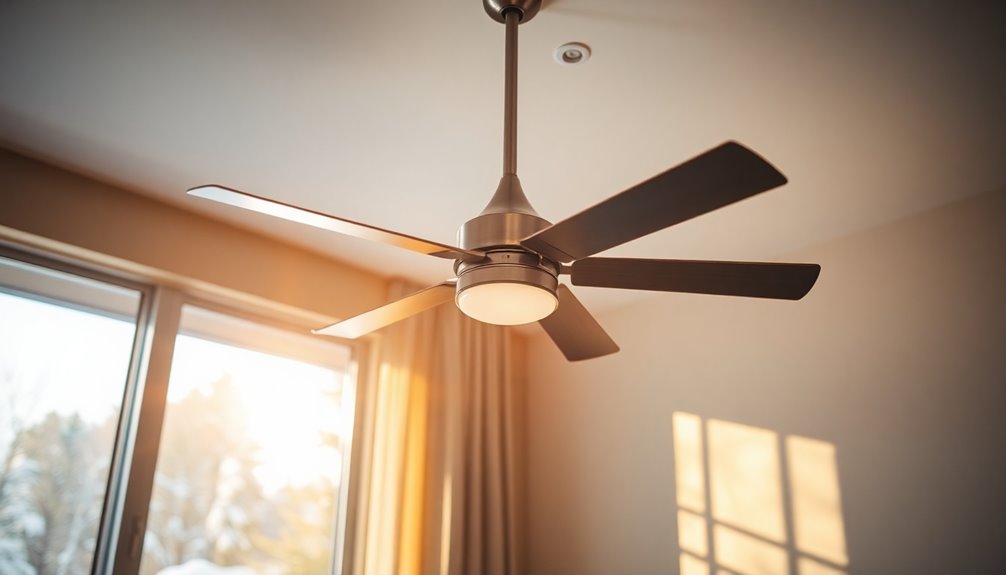
When you understand fan reversal, you can greatly enhance your home's comfort throughout the year.
By adjusting your ceiling fan direction, you can maximize its efficiency. In summer, you should run your fan counterclockwise to create a downdraft that cools your home, pushing cooler air downward and making the room feel up to 4 degrees cooler.
When winter rolls around, reverse your ceiling fan to spin clockwise, allowing it to circulate warm air that rises to the ceiling.
This simple switch not only improves thermal comfort but can also reduce energy costs—up to 30% in summer and about 15% in winter.
Ceiling Fan Direction in Winter
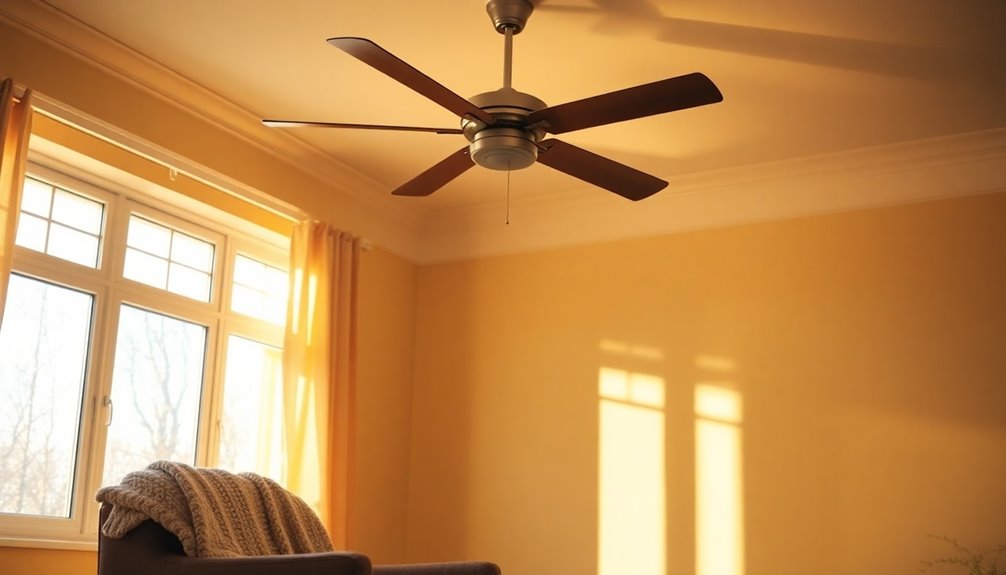
Adjusting your ceiling fan for winter is key to maintaining a cozy home environment.
To achieve this, set your ceiling fan direction to clockwise. This rotation creates an updraft that redistributes warm air that gathers near the ceiling, pushing it downwards where you need it most.
It's best to run the fan on its lowest speed in winter mode to avoid any uncomfortable drafts while still promoting warm air circulation.
This simple adjustment not only enhances thermal comfort but can also help lower your energy bill by improving heating efficiency.
Properly using your ceiling fan in winter is especially important in rooms with high ceilings, where warm air can easily stratify and leave you feeling chilly.
Benefits of Winter Mode

When you switch your ceiling fan to winter mode, you'll notice efficient heat distribution throughout your space.
This not only enhances your thermal comfort but can also lead to a reduction in energy costs.
Efficient Heat Distribution
By utilizing the reverse option on your ceiling fan, you can greatly enhance heat distribution during winter months. When you switch the fan to rotate clockwise, it helps circulate warm air that tends to rise and collect near the ceiling. This efficient heat distribution guarantees a more comfortable temperature throughout your space. Additionally, using a ceiling fan in winter can complement your heating system by improving air quality, allowing your home to achieve thermal comfort faster without wasting energy, making it an energy-efficient choice for colder seasons.
| Feature | Benefit |
|---|---|
| Ceiling Fan Switch | Easily adjustable for winter mode |
| Clockwise Rotation | Redistributes warm air downward |
| Slower Speed Operation | Prevents disturbing downdrafts |
Energy Cost Reduction
Utilizing the reverse function on your ceiling fan not only improves comfort but also plays a key role in reducing your energy costs during winter.
By setting the fan direction to clockwise, you push warm air that rises to the ceiling back down into your living space. This simple adjustment can lead to energy savings of up to 15% on heating bills, as it enhances the efficiency of your heating system.
The slower speeds recommended for winter use distribute warmth evenly, minimizing drafts and cold spots.
Enhanced Thermal Comfort
As the chill of winter sets in, activating the reverse function on your ceiling fan can greatly enhance your home's thermal comfort. When the blades rotate clockwise, they push warm air down, eliminating cold spots and creating a more consistent environment. This gentle flow of warm air prevents drafts, making your space feel cozy.
| Benefits | Description |
|---|---|
| Improved Thermal Comfort | Circulates warm air, eliminating cold spots. |
| Energy Savings | Reduces heating bills by approximately 15%. |
| High Ceiling Efficiency | Distributes warm air effectively in tall rooms. |
Ceiling Fan Direction in Summer
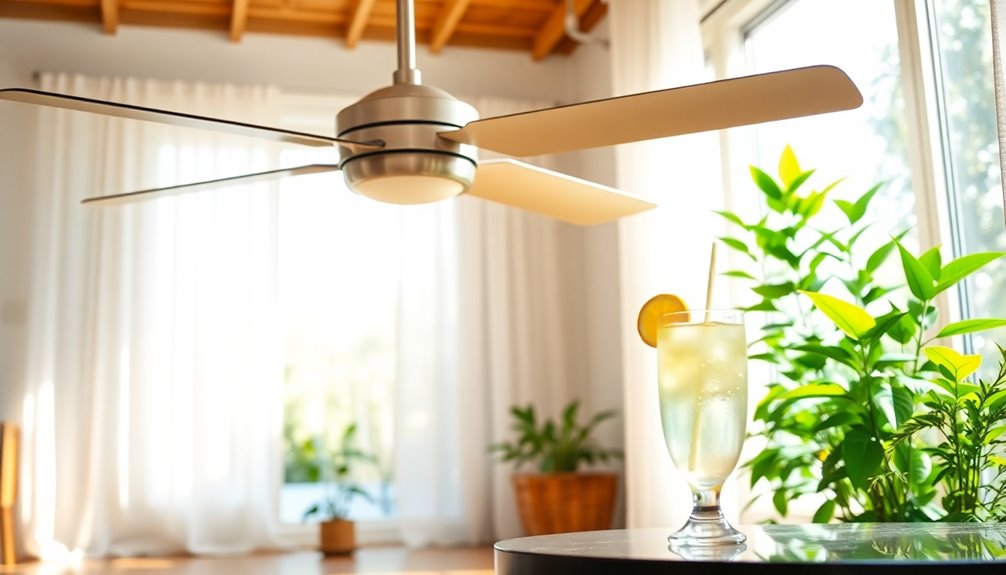
When summer heat strikes, adjusting your ceiling fan's direction can greatly enhance your comfort. Set your ceiling fan to rotate counterclockwise to maximize the cooling effects.
Here's why this matters:
- Cool air: The downdraft created by counterclockwise rotation pushes cooler air down, making the room feel up to 4 degrees cooler.
- Higher thermostat setting: You can comfortably raise your thermostat by 4 degrees without sacrificing comfort.
- Energy savings: Running the fan at high speed can lead to potential energy savings of up to 30% on cooling costs.
- Correct airflow: Using the right ceiling fan direction guarantees efficient airflow, enhancing overall cooling performance.
Additionally, using a ceiling fan in conjunction with an air purifier can further improve indoor air quality while keeping you cool. Combine your fan with air conditioning for ideal results, and turn it off when you leave for even more energy savings!
Optimal Timing for Direction Changes

To keep your home comfortable year-round, it's essential to adjust your ceiling fan's direction with the changing seasons.
You should switch to counterclockwise in the summer and clockwise in the winter, especially during Daylight Savings Time.
Setting reminders for these changes guarantees your fan operates efficiently, maximizing airflow and energy savings.
Seasonal Adjustment Recommendations
Adjusting your ceiling fan's direction at the start of each season can greatly enhance your home's comfort and energy efficiency.
Here's when to change the ceiling fan direction for ideal benefits:
- Spring Forward: Set your fan to spin counterclockwise before summer to maximize air movement, keeping you cool.
- Fall Back: Switch to a clockwise direction before winter to circulate warm air and reduce heating costs.
- Timing: Make these changes right before peak heating or cooling months for the best results.
- Consistency: Regular adjustments maintain air movement efficiency, ensuring a comfortable room temperature year-round.
Daylight Savings Time Changes
Why not take advantage of Daylight Savings Time to streamline your home comfort?
It's the perfect opportunity to adjust your ceiling fans direction for ideal airflow. When clocks spring forward, turn a ceiling fan counterclockwise to create a cooling breeze for summer.
As winter approaches and clocks fall back, switch it to clockwise to circulate warm air. This simple change not only enhances energy efficiency but can also greatly help you save money.
You could reduce cooling costs by up to 30% in summer and heating costs by 15% in winter. Aligning these adjustments with Daylight Savings Time makes it easier to maintain consistent room temperatures and rely less on your HVAC system, ensuring comfort year-round.
Optimal Fan Speed Settings
As seasons change, adjusting your ceiling fan's speed settings can make a noticeable difference in comfort and energy efficiency.
Here's how to modify your fan for the best results:
- Summer: Set your fan to high speed and make sure the blades should rotate counterclockwise. This creates a cooling downdraft, making rooms feel cooler and saving on cooling costs.
- Winter: Switch to low speed and rotate clockwise to push warm air down from the ceiling, which can enhance heating efficiency.
- Timing: Change fan direction during Daylight Savings Time for ideal comfort.
- Room Size: Use larger fans in bigger rooms for effective airflow.
Regular adjustments help maintain comfort and maximize energy savings throughout the year. Additionally, water efficiency features in modern toilets can complement your home's overall energy-saving strategy.
How to Change Fan Direction

Changing the direction of your ceiling fan is a simple yet effective way to enhance your comfort throughout the year.
To change your ceiling fan, first, always turn it off and wait for it to stop completely. If your fan has a pull chain, locate the reversing switch on the fan body and slide it to switch the direction of the ceiling fan blades.
For remote-controlled fans, press and hold the fan button on the remote until the light blinks, ensuring the fan is off.
Smart ceiling fans can be adjusted via the SIMPLEconnect app or voice commands, but make sure it's off first.
Regularly changing the direction—counterclockwise in summer and clockwise in winter—optimizes airflow and boosts energy efficiency, offering seasonal benefits.
Energy Savings From Ceiling Fans
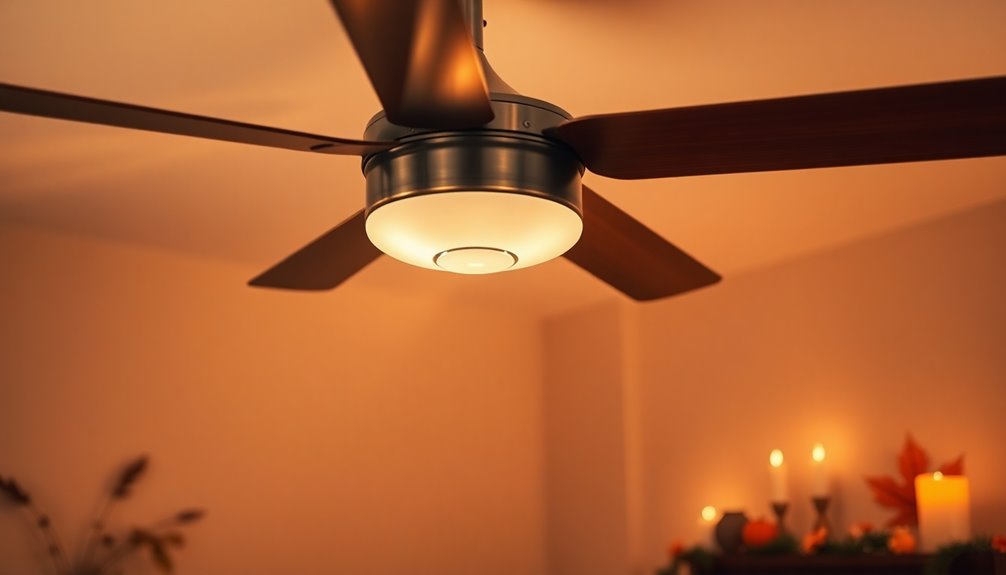
Ceiling fans not only improve comfort by adjusting airflow but also offer significant energy savings. By using a ceiling fan, you can achieve the following benefits:
- Lower Energy Use: Ceiling fans use about 60 watts, compared to 3,500 watts for air conditioning units.
- Cooling Savings: Running your fan in the right direction can cut cooling costs by up to 30%.
- Heating Efficiency: Reversing your fan in winter can reduce heating bills by about 15% by redistributing warm air.
- Extended HVAC Life: Using fans with your heating and cooling systems lowers their workload, prolonging their lifespan.
With these energy-saving strategies, you can enjoy ideal comfort all year round while keeping your utility bills in check.
Maintenance Tips for Ceiling Fans
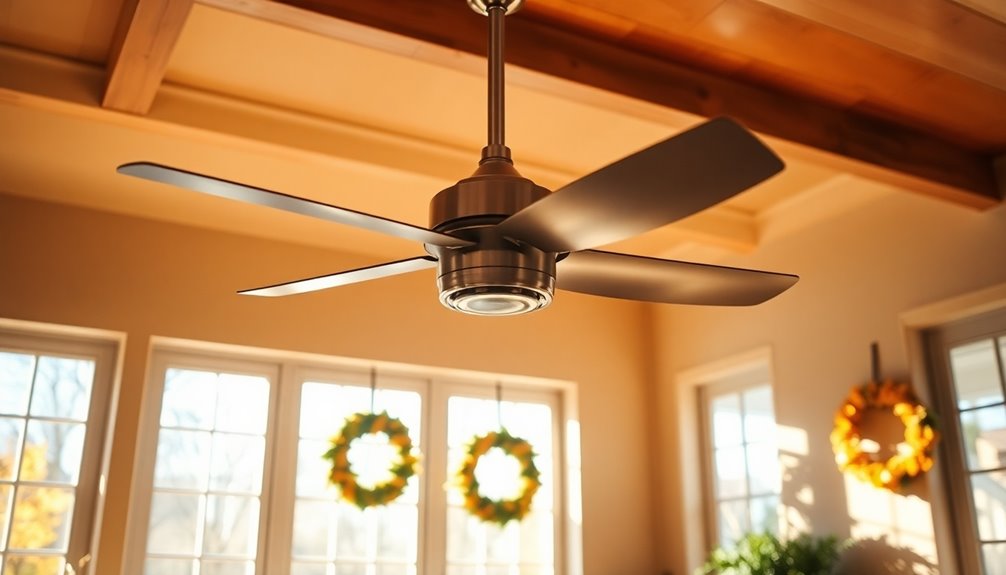
Proper maintenance is key to keeping your ceiling fan running smoothly and efficiently. Here are some essential maintenance tips to maximize your fan's performance and efficiency:
| Task | Frequency |
|---|---|
| Dust fan blades | Monthly |
| Inspect and tighten screws | Every few months |
| Replace worn parts | As needed |
| Schedule professional check | Annually |
| Adjust fan direction | Seasonally |
Regular dusting prevents airflow issues, while inspecting screws guarantees safety. Replacing damaged parts prolongs the fan's life. Don't forget to make seasonal adjustments to fan direction, as this enhances energy efficiency and comfort throughout the year. Following these tips will keep your ceiling fan in top shape!
Frequently Asked Questions
What Is the Reverse Function on a Fan For?
The reverse function on a fan lets you change the blade rotation, which can greatly affect your comfort.
When you switch it on, you can create a downdraft in summer for an invigorating breeze or push warm air down in winter to keep your space cozy.
It's an easy way to enhance your room's climate while saving on energy costs.
Just flip the switch or use the remote, and enjoy the benefits!
What Are the Benefits of a Reverse Fan?
Imagine a whirlwind of comfort sweeping through your home! The reverse fan option's benefits are like magic, transforming your space.
In winter, it redistributes warm air, making you feel snug while slashing heating bills. In summer, it creates a revitalizing breeze that cools you down, almost like a gentle ocean wave.
With this simple switch, you're not just saving energy; you're crafting a cozy haven year-round. Embrace the comfort and enjoy the savings!
What Does Putting Your Fan in Reverse Do?
When you put your fan in reverse, you change the direction of the blade rotation. This simple adjustment can make a big difference in your comfort.
In winter, it helps circulate warm air that gathers near the ceiling, making your space feel cozier.
In summer, reversing the fan creates a cooling breeze that can lower the perceived temperature in your room.
It's an easy way to enhance comfort while potentially saving on energy costs!
What's the Point of Reverse Blade Fans?
The point of reverse blade fans is to enhance your comfort throughout the year.
By switching the blade direction, you can either create a cooling breeze in summer or redistribute warm air in winter.
This simple adjustment can help you save on energy costs while keeping your space more comfortable.
You'll notice the difference in air circulation, making your home feel just right, no matter the season.
It's an easy and effective solution!
Conclusion
So, while you might think a ceiling fan just spins mindlessly, it actually has a clever trick up its sleeve. By switching directions, it can either chase away the winter chill or stir up a invigorating summer breeze. Who knew that a simple flip of a switch could transform your living space from a frosty tundra to a sun-kissed paradise? Embrace the irony—your fan's secret life could be saving you money while keeping you cozy or cool!
